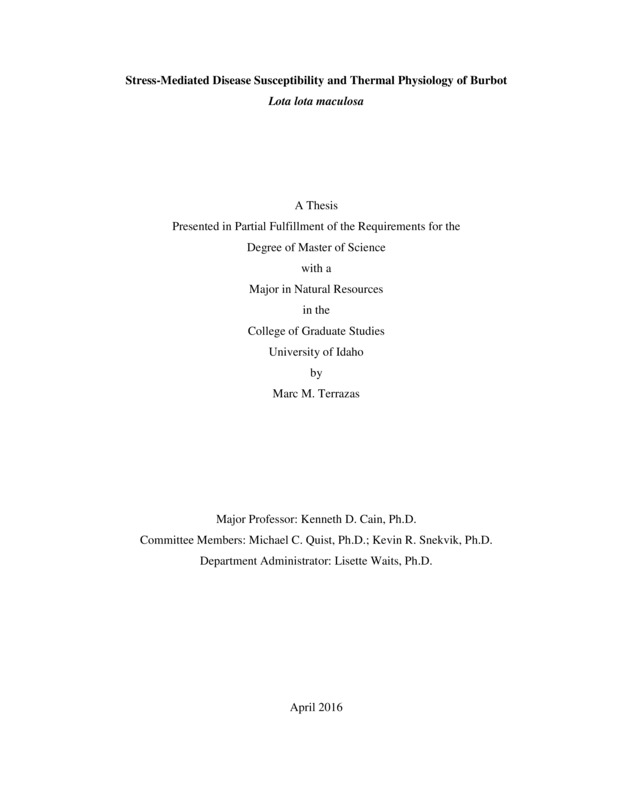Stress-Mediated Disease Susceptibility and Thermal Physiology of Burbot Lota lota maculosa
Terrazas, Marc. (2016). Stress-Mediated Disease Susceptibility and Thermal Physiology of Burbot Lota lota maculosa. Theses and Dissertations Collection, University of Idaho Library Digital Collections. https://www.lib.uidaho.edu/digital/etd/items/terrazas_idaho_0089n_10846.html
- Title:
- Stress-Mediated Disease Susceptibility and Thermal Physiology of Burbot Lota lota maculosa
- Author:
- Terrazas, Marc
- Date:
- 2016
- Keywords:
- Burbot conservation disease physiology temperature thermal maxima
- Program:
- Natural Resources
- Subject Category:
- Natural resource management; Wildlife conservation
- Abstract:
-
A series of experiments were intiated at the University of Idaho to evaluate the influence of stress on Burbot Lota lota maculosa. Stress as it links to pathogenic bacteria and thermal stress were evaluated as they pertain to initial culture efforts, continued persistence, and habitat evaluation of Burbot. Population declines of Burbot in the Kootenai River, Idaho have initiated a conservation program for this population with captive rearing creating novel animal health problems and thermal conditions of important Burbot habitat have created questions of suitability. Periodic epizootics of unknown pathogens during stress events provided bacterial isolates of interest in regards to Burbot survival. Regional stream temperatures provided information about thermal conditions and allowed the initiation of experimental evaluation of the influence of temperature on Burbot physiology and survival. Burbot were injected and immersed in bacterial isolates from previous epizootics and mortality was evaluated as the response. Burbot were also subjected to fluctuating water temperatures creating high diel spikes similar to what is observed in natural systems. Pathogenic isolates of interest include two Aeromonas sp. that are both novel pathogens to Burbot and potentially novel species. The thermal response of Burbot was found to be resilient to diel increases in temperature with increased heat shock protein 70 induction and gene expression, but resulted in lower growth than controls. Upper lethal maximums of over 31°C were also observed.
- Description:
- masters, M.S., Natural Resources -- University of Idaho - College of Graduate Studies, 2016
- Major Professor:
- Cain, Kenneth K
- Committee:
- Snekvik, Kevin R; Quist, Michael C
- Defense Date:
- 2016
- Identifier:
- Terrazas_idaho_0089N_10846
- Type:
- Text
- Format Original:
- Format:
- application/pdf
- Rights:
- In Copyright - Educational Use Permitted. For more information, please contact University of Idaho Library Special Collections and Archives Department at libspec@uidaho.edu.
- Standardized Rights:
- http://rightsstatements.org/vocab/InC-EDU/1.0/

